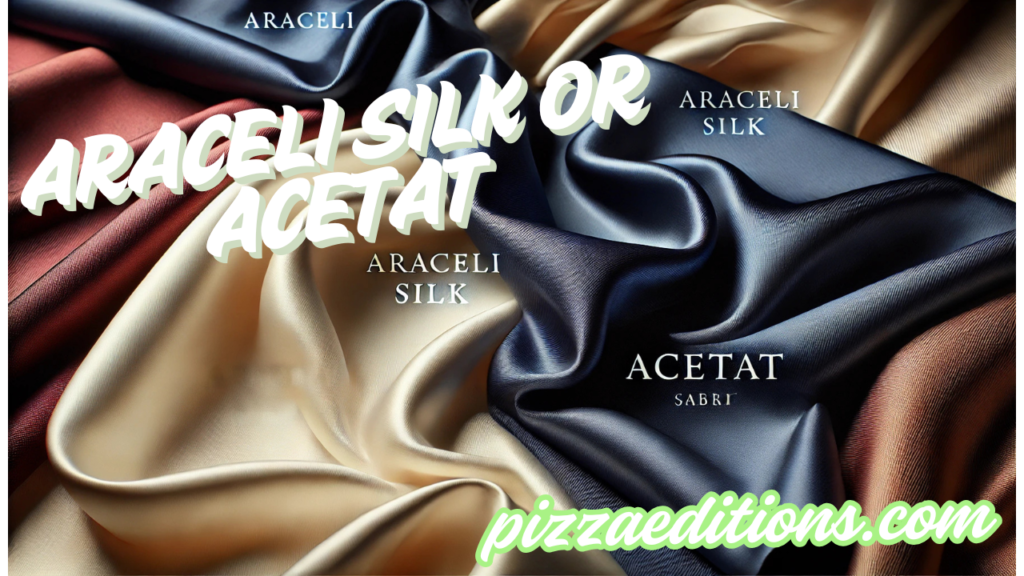Introduction to Araceli Silk or Acetat
When it comes to luxurious and elegant fabrics, Araceli Silk or Acetat often emerges as a topic of discussion among fashion designers, textile manufacturers, and fabric enthusiasts. These materials, known for their smooth texture, glossy finish, and versatile applications, are widely used in the production of clothing, upholstery, and accessories. In this article, we will explore the characteristics, advantages, and common uses of Araceli Silk or Acetat to provide a comprehensive understanding of these fabrics.
What is Araceli Silk or Acetat?
Araceli Silk is often associated with high-end fabrics, prized for its soft texture and natural sheen. This type of silk is typically woven from fine fibers, offering a luxurious feel and elegant drape. On the other hand, Acetat (or Acetate) is a synthetic fiber derived from cellulose, often used as a silk substitute due to its affordability and durability.
While both fabrics share similar visual properties, they differ significantly in their composition, maintenance, and applications. Understanding these differences is crucial for anyone interested in textiles, whether for fashion design, home decor, or commercial manufacturing.
Characteristics of Araceli Silk or Acetat
1. Texture and Appearance
Araceli Silk has a soft and smooth texture with a natural luster that enhances its luxurious appeal. It drapes beautifully, making it a preferred fabric for elegant clothing. Acetat, on the other hand, mimics silk’s shine and softness but has a slightly more structured feel.
2. Breathability and Comfort
Silk is a natural fiber, making it highly breathable and comfortable to wear in different climates. It helps regulate body temperature by keeping the wearer cool in warm weather and warm in colder conditions. Acetat, while lightweight and soft, is not as breathable as silk, making it less suitable for prolonged wear in extremely hot conditions.
3. Durability and Strength
While silk is known for its strength relative to its weight, it requires delicate care to maintain its integrity. It can weaken over time, especially if exposed to sunlight and moisture. Acetat is more resistant to shrinking and wrinkles but is also more susceptible to heat damage and discoloration.
4. Maintenance and Care
Silk demands delicate handling, usually requiring dry cleaning or handwashing with mild detergent. It should not be wrung out or exposed to excessive sunlight. Acetat, being a semi-synthetic material, can tolerate machine washing but should be kept away from high temperatures and excessive ironing to avoid melting or deformation.
Common Uses of Araceli Silk or Acetat
1. Fashion and Apparel
One of the most significant applications of Araceli Silk or Acetat is in the fashion industry. Silk is widely used in evening gowns, bridal dresses, luxury scarves, and high-end blouses. Acetat serves as a budget-friendly alternative, often used in linings, dresses, and imitation satin fabrics.
2. Upholstery and Home Decor
Both fabrics are popular in home decor. Silk is used in high-end draperies, cushion covers, and bed linens to add a touch of sophistication. Acetat, being more durable and wrinkle-resistant, is a preferred choice for furniture upholstery and curtain linings.
3. Accessories and Handicrafts
Silk and Acetat are also widely used in accessories such as ties, scarves, and handbags. Their lustrous finish makes them attractive for fashion-forward items. Acetat is often used in ribbons, artificial flowers, and decorative elements due to its ability to hold color and structure well.
Advantages of Araceli Silk or Acetat
1. Luxurious Aesthetic Appeal
Both fabrics offer a sophisticated and elegant appearance, making them ideal for high-end fashion and decor.
2. Versatility in Use
From clothing to home decor, the applications of Araceli Silk and Acetat are vast, catering to various industries.
3. Cost-Effectiveness
Acetat provides a more affordable alternative to silk, allowing consumers to enjoy the look and feel of luxury without the high price tag.
4. Wide Range of Colors and Patterns
Both fabrics can be dyed in vibrant colors and intricate patterns, making them versatile for different design needs.
Disadvantages and Considerations
1. Sensitivity to Heat and Moisture
Silk is prone to water stains and needs careful handling, while Acetat can melt or warp under high heat.
2. Environmental Concerns
While silk is a natural fiber, its production can have ethical and environmental implications. Acetat, being semi-synthetic, has its own sustainability concerns, especially in terms of biodegradability and chemical processing.
3. Special Care Requirements
Both fabrics require specific care methods to maintain their longevity and appearance, which can be inconvenient for some users.
Conclusion
Araceli Silk or Acetat are two highly regarded fabrics, each with its unique set of properties and applications. While silk is a natural, luxurious material favored for its softness and elegance, Acetat serves as a practical alternative, offering durability and affordability. Understanding the differences between these fabrics helps consumers make informed choices, whether for fashion, home decor, or textile manufacturing. By selecting the right fabric based on specific needs and preferences, users can enjoy the benefits of both Araceli Silk and Acetat in their respective domains.
